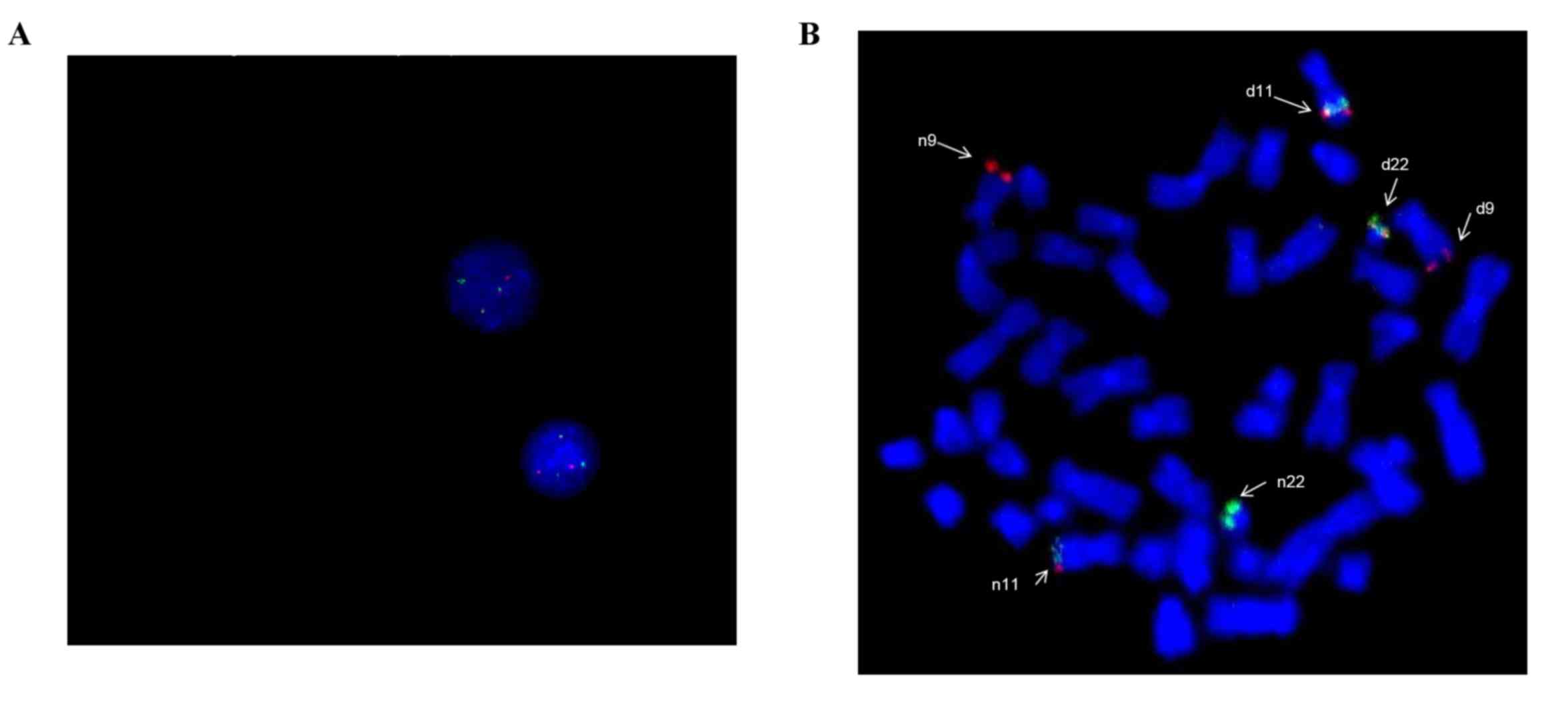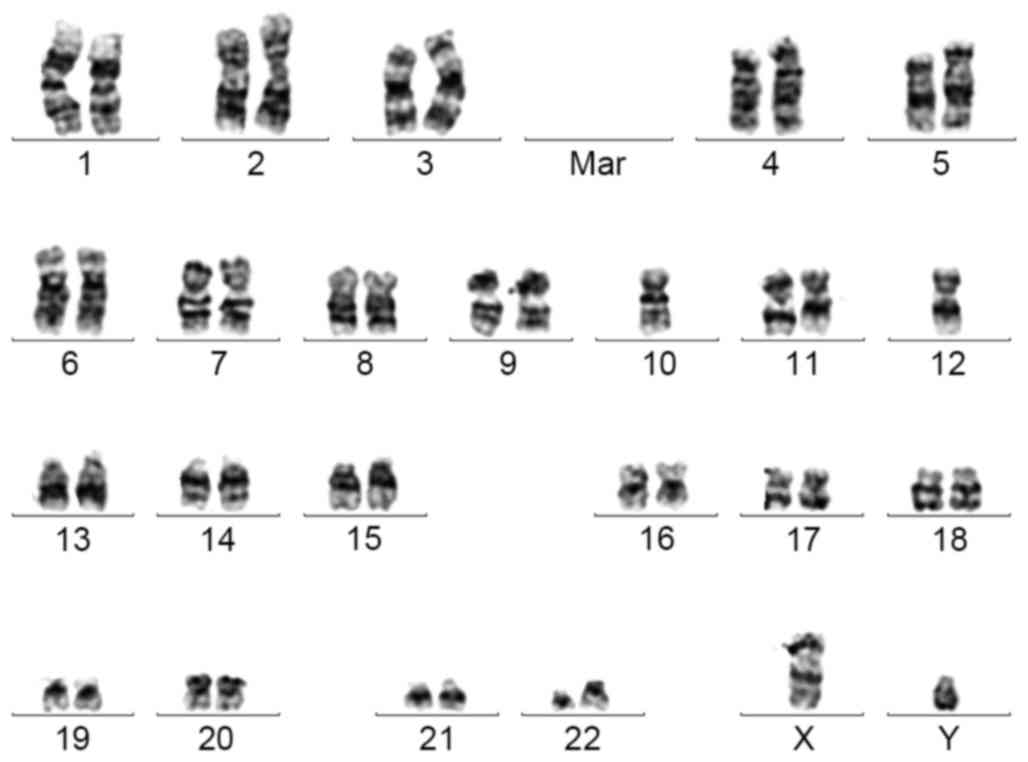Introduction
Of patients with chronic myeloid leukemia (CML),
5–10% exhibit a Philadelphia (Ph) translocation variant involving
≥1 chromosomes in addition to chromosomes 9 and 22 (1). Although the distribution of the
breakpoints exhibited a clearly nonrandom pattern in all
chromosomes involved, there was a marked clustering in the
chromosomal bands 1p36, 3p21, 5q13, 6p21, 9q22, 11q13, 12p13,
17p13, 17q21, 17q25, 19q13, 21q22, 22q12 and 22q13, suggesting that
these regions may be particularly prone to breakage (2). The variant translocations affect
additional chromosomal regions, producing different disease
phenotypes. However, previous studies investigating ~100 cases of
variant Ph chromosome translocations have not identified any impact
on cytogenetic and molecular responses, or on patient outcome,
compared with cases with a standard Ph chromosome (3,4). The
majority of three-way t(9;22;11) variants of CML involve the 11q13
or 11p15 regions of chromosome 11 (1,5–11). The 11q24 region has not previously
been investigated in a three-way Ph variant.
Case presentation
A 22-year-old male was admitted to Chonbuk National
University Hospital (Jeonju, Korea) for the evaluation and
management of dizziness and severe leukocytosis in July 2011. The
patient exhibited hepatosplenomegaly at admission without any other
known chronic diseases. The initial complete blood count showed
hemoglobin, 6.6 g/dl (normal range, 13–18 g/dl); platelets,
492.0×109/l (normal range,
150.0–450.0×109/l); and white blood cells,
590.8×109/l (normal range, 4.8–10.8×109/l)
with 8.0% myeloblasts, 71.6% neutrophils, 4.5% lymphocytes, 4.5%
monocytes, 9.1% eosinophils and 2.3% basophils. Bone marrow
aspiration and biopsy findings were indicative of chronic phase CML
with 8.0% of myeloblasts demonstrating granulocytic hyperplasia.
The karyotype of the patient was 46, XY, t(9;22;11)(q34;q11.2;q24)
in all metaphase cells analyzed (Fig.
1). A fluorescence in situ hybridization (FISH) analysis
using a commercial BCR/ABL fusion probe (AbbottMolecular Inc., Des
Plaines, IL, USA) identified the following out of total 200
interphase nuclei: 2 interphase nuclei with 1 single red signal
(ABL1, 9q34), 1 single green signal (BCR, 22q11.2) and 2 fusion
signals; 197 nuclei with 2 single red signals, 2 single green
signals and 1 fusion signal; and 1 nucleus with 2 single reds, 1
single green and 1 fusion signal (Fig.
2A). MLL (11q23.1) break-apart FISH didn't show any
rearrangement. Multiplex reverse transcription-polymerase chain
reaction (RT-PCR) analysis using the Multiplex Nested RT-PCR
HemaVision® kit (cat. no. HV01-28N; DNA Diagnostics,
Risskov, Denmark) was performed according to manufacturer's
instructions, with 2 sequential nested PCR reactions using primers
included in the kit, in order to detect translocations. RNA was
extracted from bone marrow samples using the High Pure RNA
Isolation kit (Roche Diagnostics, Mannheim, Germany) as described
previously (12). A major BCR-ABL
fusion transcript, type b3a2, was detected. Thus, the patient was
diagnosed with chronic phase CML, and imatinib treatment was
reinitiated. The patient had demonstrated a complete hematological
response for 1 year subsequent to the start of treatment, but then
stopped taking the medication. The patient was readmitted due to
leukocytosis found in the laboratory test. Bone marrow findings
showed that the initial diagnosis and the karyotype had not
changed. Additional FISH analysis using BCR/ABL dual fusion and MLL
break-apart probes revealed that the Ph chromosome was derived from
a simple variant t(9;22) via a one-step mechanism, that ABL
proto-oncogene 1 (c-ABL; 9q34, red) had moved to a BCR (22q11.2,
green) and formed a fusion (Ph), BCR had moved to 11q24, and 11q24
moved to 9q34, whereas part of c-ABL remained, indicated by a red
signal (Fig. 2B).
 | Figure 2.FISH images analyzed in (A) interphase
(magnification, ×400) and (B) metaphase cells (magnification,
×1,000). In metaphase FISH analysis, BCR/Abelson murine leukemia
viral oncogene homolog 1 dual fusion and MLL break-apart probes
were used, revealing 2 fusion events. The first is a Philadelphia
chromosome, indicated by arrow d22, and the second is derivative
chromosome 11, on which BCR moved to 11q24. FISH, fluorescence
in situ hybridization; n, normal; d, derivative. |
In contrast to the 2 expected fusion signals on
classic Ph translocations, in the present study only 1 fusion
signal was revealed, indicating a one-step mechanism, such as a
simultaneous break in 9q34, 11q24 and 22q11.2 followed by a
mismatched joining of the broken ends. Band 11q24 in this case has
never been reported as a partner for Ph translocations.
Discussion
A three-way Ph translocation variant involving 11q24
associated with CML has never been described. Variant Ph
translocations have been divided into simple variant translocations
involving chromosome 22 and another chromosome, and complex variant
translocations involving chromosomes 9 and 22 and 1–3 other
chromosomes (2,13). Two different mechanisms are known to
generate variant three-way translocations, a one-step mechanism in
which chromosomal breaks occur simultaneously on 3 different
chromosomes and a two-step mechanism involving 2 sequential
translocations in which a standard t(9;22) translocation is
followed by a second translocation involving additional chromosomes
(14–16). The case presented in the present study
was considered to be a simple variant translocation generated by a
one-step mechanism. A variant translocation generated by a two-step
mechanism is similar to clonal evolution, thus this mechanism may
be associated with a poorer prognosis. The case of the present
study showed a one-step variant translocation clinically identical
to classic Ph translocations.
Variant translocations may possibly affect the
course of the disease by altering the structure of the tyrosine
kinase ligand binding site. Although numerous studies have
addressed the possible effect of variant translocations on the
clinical course of chronic phase CML, contradictory results have
been reported (3,4,17).
Previous studies have indicated that the clinical, prognostic and
hematological features of types of CML exhibiting variant
translocations are not distinct from types of CML exhibiting
classic translocations, but the majority of these studies were
based on a small series or literature reviews (2–4). Band
11q24, as a variant translocation partner, is a novel region that
has not been investigated. Thus, the present study possessed no
information on the clinical course or hematological features of CML
with t(9;22;11) (q34;q11.2;q24). However, the patient of the
present study experienced chronic phase CML twice with the same
chromosomal abnormality, thus the clinical course between the first
diagnosis and the relapse was compared. A three-way variant
t(9;22;11) involving 11q24 was detected at the initial diagnosis,
and the relapse samples indicated that the CML was in the chronic
phase at the initial and relapse diagnoses. The clinical course of
the patient was also similar prior and subsequent to relapse.
References
|
1
|
Naumann S and Decker HJ: Genesis of
variant Philadelphia chromosome translocations in chronic
myelocytic leukemia. Cancer Genet Cytogenet. 147:18–22. 2003.
View Article : Google Scholar : PubMed/NCBI
|
|
2
|
Fioretos T and Johansson B: Chronic
Myeloid LeukemiaCancer Cytogenetics. Heim S and Mitelman F: John
Wiley and Sons, Inc.; Hoboken, New Jersey: 2009
|
|
3
|
Fabarius A, Leitner A, Hochhaus A, Müller
MC, Hanfstein B, Haferlach C, Göhring G, Schlegelberger B,
Jotterand M, Reiter A, et al: Impact of additional cytogenetic
aberrations at diagnosis on prognosis of CML: Long-term observation
of 1151 patients from the randomized CML Study IV. Blood.
118:6760–6768. 2011. View Article : Google Scholar : PubMed/NCBI
|
|
4
|
Marzocchi G, Castagnetti F, Luatti S,
Baldazzi C, Stacchini M, Gugliotta G, Amabile M, Specchia G,
Sessarego M, Giussani U, et al: Variant Philadelphia
translocations: Molecular-cytogenetic characterization and
prognostic influence on frontline imatinib therapy, a GIMEMA
Working Party on CML analysis. Blood. 117:6793–6800. 2011.
View Article : Google Scholar : PubMed/NCBI
|
|
5
|
Anelli L, Albano F, Zagaria A, Liso A,
Roberti MG, Rocchi M and Specchia G: A chronic myelocytic leukemia
case bearing deletions on the three chromosomes involved in a
variant t(9;22;11). Cancer Genet Cytogenet. 148:137–140. 2004.
View Article : Google Scholar : PubMed/NCBI
|
|
6
|
Kim HS, Cho HC, Kim SH, Moon Y, Nahm CH,
Choi JW and Kim JJ: Chronic myelogenous leukemia with a variant
philadelphia translocation: t(11;22)(q25;q11.2)]. Korean J Lab Med.
26:246–248. 2006. View Article : Google Scholar : PubMed/NCBI
|
|
7
|
Belli C, Alú MF, Alfonso G, Bianchini M
and Larripa I: Novel variant Ph translocation
t(9;22;11)(q34;q11.2;p15)inv(9)(p13q34) in chronic myeloid leukemia
involving a one-step mechanism. Cytogenet Genome Res. 132:304–308.
2011. View Article : Google Scholar : PubMed/NCBI
|
|
8
|
Kumar S, Apostolova M and Woolley PV: A
case of chronic myelogenous leukemia in pregnancy characterized by
a complex translocation t(9;22;11)(q34;q11.2;q13). Hematol Rep.
3:e272011. View Article : Google Scholar : PubMed/NCBI
|
|
9
|
Yokota S, Nakamura Y and Bessho M: A novel
five-way translocation t(7;11;9;22;9)(q22;q13;q34;q11.2;q34)
involving Ph chromosome in a patient of chronic myeloid leukemia: A
case report. Mol Cytogenet. 5:202012. View Article : Google Scholar : PubMed/NCBI
|
|
10
|
Al-Achkar W, Wafa A and Liehr T: A new
t(9;11;20;22)(q34;p11.2;q11.21;q11) in a Philadelphia-positive
chronic myeloid leukemia case. Oncol Lett. 5:605–608.
2013.PubMed/NCBI
|
|
11
|
Aliano S, Cirmena G, Fugazza G, Bruzzone
R, Palermo C and Sessarego M: Standard and variant Philadelphia
translocation in a CML patient with different sensitivity to
imatinib therapy. Leuk Res Rep. 2:75–78. 2013.PubMed/NCBI
|
|
12
|
Salto-Tellez M, Shelat SG, Benoit B,
Rennert H, Carroll M, Leonard DG, Nowell P and Bagg A: Multiplex
RT-PCR for the detection of leukemia-associated translocations:
Validation and application to routine molecular diagnostic
practice. J Mol Diagn. 5:231–236. 2003. View Article : Google Scholar : PubMed/NCBI
|
|
13
|
Melo JV: The molecular biology of chronic
myeloid leukaemia. Leukemia. 10:751–756. 1996.PubMed/NCBI
|
|
14
|
Huret JL: Complex translocations, simple
variant translocations and Ph-negative cases in chronic myelogenous
leukaemia. Hum Genet. 85:565–568. 1990. View Article : Google Scholar : PubMed/NCBI
|
|
15
|
Gorusu M, Benn P, Li Z and Fang M: On the
genesis and prognosis of variant translocations in chronic myeloid
leukemia. Cancer Genet Cytogenet. 173:97–106. 2007. View Article : Google Scholar : PubMed/NCBI
|
|
16
|
Richebourg S, Eclache V, Perot C, Portnoi
MF, Van den Akker J, Terré C, Maareck O, Soenen V, Viguié F, Laï
JL, et al: Mechanisms of genesis of variant translocation in
chronic myeloid leukemia are not correlated with ABL1 or BCR
deletion status or response to imatinib therapy. Cancer Genet
Cytogenet. 182:95–102. 2008. View Article : Google Scholar : PubMed/NCBI
|
|
17
|
Johansson B, Fioretos T and Mitelman F:
Cytogenetic and molecular genetic evolution of chronic myeloid
leukemia. Acta Haematol. 107:76–94. 2002. View Article : Google Scholar : PubMed/NCBI
|
















